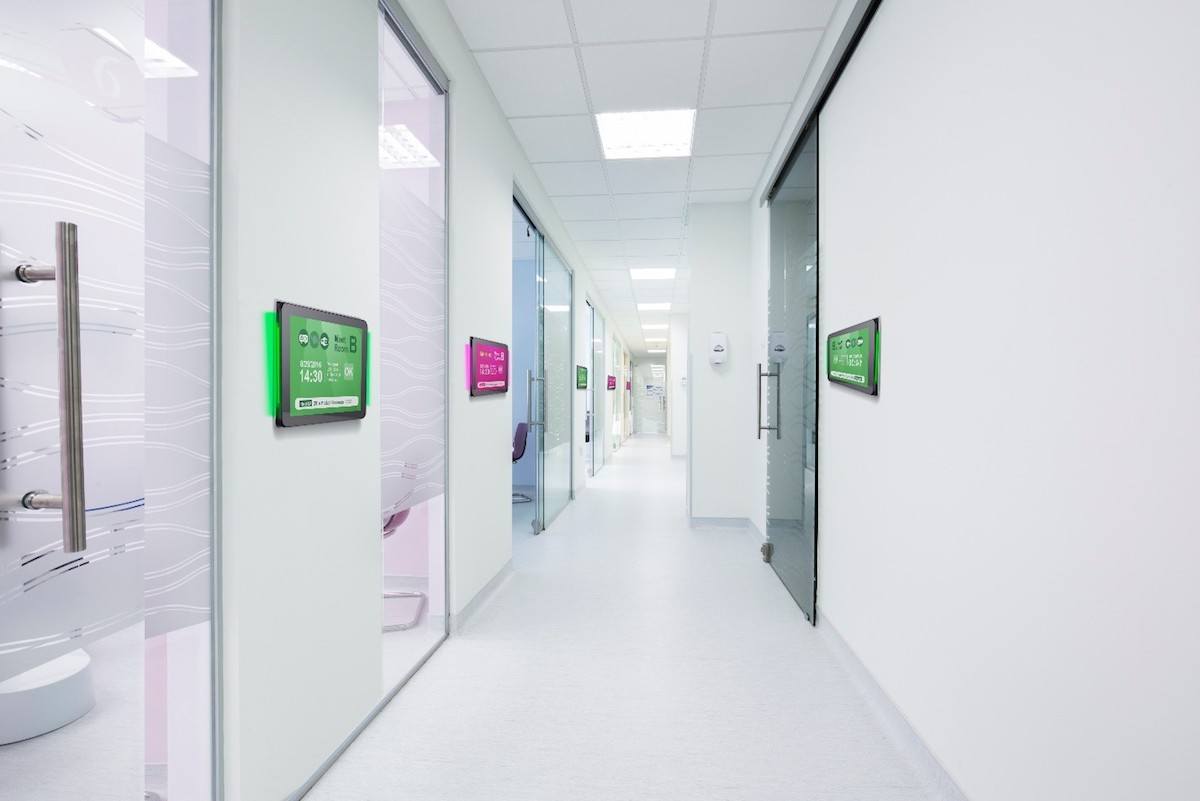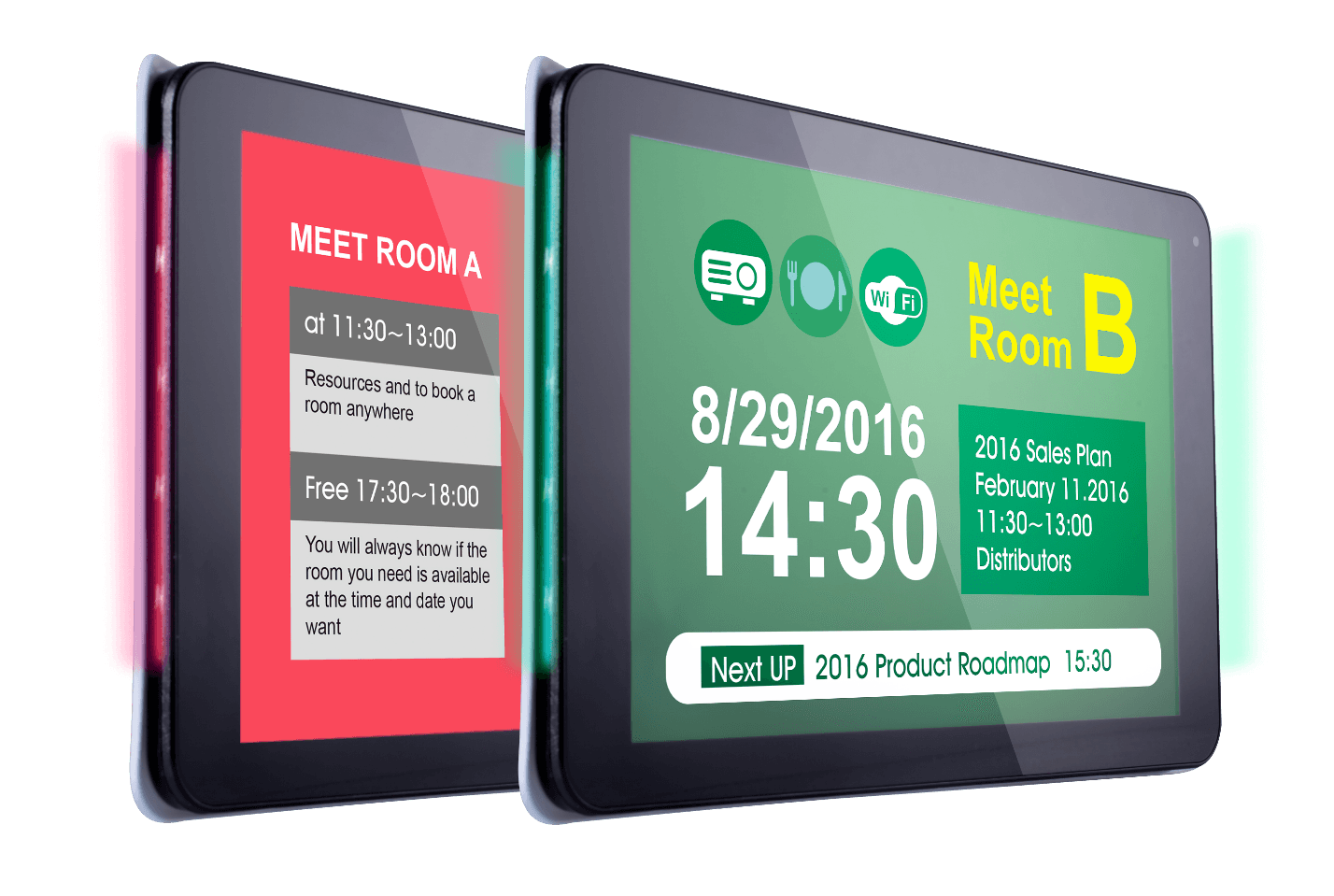
Why All Room Management Signboards Are Not Created Equal
December 6, 2017 by guest author, Jami McGraw
Guest Post: John Wang, IAdea
The modern workplace is undergoing a digital transformation, reinvented with the latest technologies to strengthen employee productivity, improve returns of investments on the facilities and enhance corporate image for visitors.

John Wang
One of the most significant changes happening at the doorsteps of the meeting room is the installation of a “room management signboard” display by each entrance, which serves as an interactive door sign. A rapidly growing list of corporations, educational institutions, and conference venues are benefiting from this newly evolved digital signage application as part of today’s integrated workplace system management initiative.
Some of the early market pioneers adapted consumer tablets, such as the iPad, to serve in this capacity. They soon ran into “inconveniences” such as lack of prominent color LED light bars, which signal room availability at a glance across the hall, to major obstacles in the form of connectivity, power supply, mounting, and system software imposed limitations.
Without prior planning at the product and the systemic levels, mere inconveniences can escalate to a total breakdown of an otherwise groundbreaking innovation in spatial design.
Wi-Fi is Not Designed For Reliable Networking
Consumer tablets are mobile devices meant to be thin, light and most importantly, handheld, making it difficult to fit a reliable Ethernet RJ-45 connector into the device. Instead, these devices are fitted with “Wi-Fi” or “wireless LAN” networking technology. While wireless LAN with its various generations of improvements are convenient to set up and use for personal mobile devices, they are by no means robust enough to serve as the underpinnings of a well-planned, corporate communications infrastructure.
Wireless LANs operate on either 2.4GHz or 5GHz bands. The 2.4GHz band is shared with Bluetooth, which constantly emits interfering noise signals. Even worse, the 2.4Ghz band contains the natural resonance frequency of water, which is used to “excite” or heat up water molecules in every microwave oven. If your wireless network works poorly during the lunch hour, chances are someone in the building is heating up lunch with a microwave.
While the 5GHz band may experience less interference, its shorter wavelength means the signal path is easily blocked by building materials, requiring additional repeaters and antennas for line-of-sight connectivity, incurring additional costs and risks. In short, using wireless LAN for fixed installations in the built environment, in place of wired networking infrastructure, is a terrible bet.
The industry’s best practice for deploying room management digital signboards at a corporate headquarters, a business hotel or a post-secondary campus, is wired networking.

Excess Wiring Increases Cost And Points-of-Failure
Of course, adding a wire may add to the complexity and cost of deployment. A specialized device that features the RJ-45 connector is, in many cases, almost mandatory. The RJ-45 cable is also likely to require both a power cable and a network cable to operate. Not only would RJ-45 cable add to the cost of wiring, the nature of the RJ-45 cable design makes it difficult for installers to hide the cable(s) for a clean installation.
Luckily, Power-over-Ethernet technology, also known as PoE, is popular with the best room management digital signboards, to simplify deployment with wired networking. This standard reduces power and networking cabling down to a single wire, and is very popular among today’s IP-based surveillance cameras. Chances are, your building may already have PoE infrastructure in place, making it very easy to add PoE-based digital signboards.
Minimize Impact Of Mounting On Design Aesthetics, Even On Glass
An inexperienced digital signboard manufacturer may often overlook the art of installation. When a system integrator purchases from an inexperienced supplier, incorporating a room management signboard into the design of an office space may become a challenge. The common way to fix a device on the wall may involve using a VESA-standard bracket, but this creates dead space and adds to the thickness of the protruding screen.
A properly designed room management signboard should have integral mounting mechanisms rather than as an accessory. For example, sophisticated products include a backplate that can be removed to be used as the wall mount. Mounting such devices is extremely easy: the backplate is first fixed to the wall, then the signboard device attached securely to the backplate. The result is a beautiful, gap-less installation that attaches perfectly on the wall.
As modern offices tend to utilize glass partitions, the aesthetics of the backplate matters even more. The backplate is designed to be attached to the glass partition using off-the-shelf, clear double-sided adhesive strips. Then the signboard may be effortlessly installed onto the backplate for a clean, seamless look. Combined with the single-wire PoE cabling, the entire glass-mounted installation appears minimalistic.
Be Future-proof
Ultimately, what makes a room management signboard great? It’s not just the hardware or mechanical design of the device itself, but the diverse ecosystems which allow digital transformation to truly thrive.
It is important to choose an open platform that is supported by leading software partners, avoiding duplication of time and effort. For example, my company, IAdea, is building an ecosystem around the room management signboard, with partners including Signagelive, Concierge, Display5, Meetio, and YArooms. Each of these partners provide a differentiating room management solution that meets specific needs, with local support resources in specific regions.
An open platform philosophy means that there are no arbitrary business decisions constricting the functionality of technologies and the impediment of expertise, nor their ability to come together to bring value to your organization. On the contrary, it is a way for every partner to contribute know-how and provide the best technologies to better serve in each context and help you meet every business objective.
So for your next project, whether it’s for a smart building or an integrated workplace, consider a platform that provides reliable connectivity, power supply, and mounting, as well as being designed, from the ground up, to work with a rich set of third-party software options. This way you will never run out of solutions to meet each new requirement as they surface into view.



Leave a comment